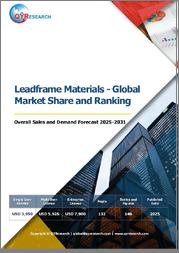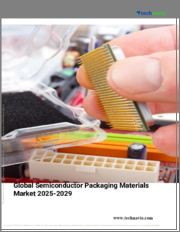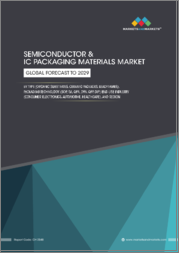
|
시장보고서
상품코드
1775336
세계의 반도체 패키징 재료 시장 예측(2025-2030년)Semiconductor Packaging Material Market - Forecasts from 2025 to 2030 |
||||||
세계의 반도체 패키징 재료 시장은 CAGR 5.20%로, 2025년 224억 7,600만 달러에서 2030년까지 289억 5,300만 달러로 성장할 것으로 예측됩니다.
반도체 패키징 재료는 집적 회로(IC) 및 반도체를 부식 및 환경 손상으로부터 보호하고 안정적인 칩 연결을 보장하는 데 필수적입니다.
시장 동향
반도체 패키징 재료 시장은 세계의 반도체 산업과 밀접한 관계에 있습니다. 사물인터넷(IoT), 기계학습, 인공지능(AI) 등의 기술이 침투하고 있는 것은 시장 개척에 큰 영향을 미칠 것으로 예측됩니다.
아시아태평양은 주요 산업이 집중되고 있는 것, 인건비가 싼 것, 전자기기 수요가 높아지고 있는 것, 기술 진보가 계속되고 있는 것으로부터, 시장을 독점할 것으로 예측되고 있습니다.
주요 시장 성장 촉진요인
1. 자동화 및 산업 투자 증가
IoT, 자동화, AI, 클라우드 기반 소프트웨어의 보급으로 세계의 산업 투자가 급증하고 있습니다.
이 동향을 나타내는 중요한 지표는 세계의 로봇 밀도의 상승입니다. 로봇은 외부 데이터 처리를 위해 반도체에 의존하고 있으며 자동화가 진행됨에 따라 반도체 패키징 재료 수요가 크게 증가할 것으로 예측됩니다.
2.전자기기의 보급 확대
경제 성장에 의해 세계 가처분소득이 증가하여 스마트폰, 노트북, 기타 가전제품 등의 전자기기 수요가 높아지고 있습니다. 전기자동차 및 하이브리드 차량의 보급은 이 동향의 현저한 예입니다. EV에는 배터리 관리, 소프트웨어 시스템, 다양한 기능성을 위한 반도체가 필요하며, 그 모두가 부식이 없는 신뢰성이 높은 것이어야 합니다.
시장 성장 억제요인
1. 세계 반도체 칩 부족
현재 진행 중인 세계 반도체 칩 부족은 패키징 재료 시장에 있어 여전히 큰 과제입니다. 칩 생산의 감소는 패키징 재료 수요에 직접 영향을 미치고 시장 성장의 병목이 되고 있습니다.
2. 원재료 비용 상승
원재료비의 상승도 큰 발목이 되고 있습니다. 이러한 비용 압력은 이익률을 낮추고 제조업체의 재무 부담을 늘리면 시장 성장을 제한 할 수 있습니다. 이러한 문제를 해결하려면 전략적 공급망 관리 및 비용 최적화 노력이 필요합니다.
이 보고서의 주요 이점
- 인사이트가 풍부한 분석 : 고객 부문, 정부 정책 및 사회 경제 요인, 소비자 선호, 산업별 및 기타 하위 부문에 중점을 두고 주요 지역 및 신흥 지역을 다루는 상세한 시장 인사이트를 얻을 수 있습니다.
- 경쟁 구도 : 세계의 주요 기업이 채용하는 전략적 전략을 이해하고 적절한 전략에 의한 시장 침투 가능성을 이해할 수 있습니다.
- 시장 동향과 촉진요인 : 다이나믹한 요인과 매우 중요한 시장 동향, 그리고 그것들이 향후 시장 개척을 어떻게 형성해 나갈까를 찾습니다.
- 행동 가능한 제안: 인사이트를 전략적 의사 결정에 활용해, 역동적인 환경 속에서 새로운 비즈니스 스트림과 수익을 발굴합니다.
- 폭넓은 이용자에 대응: 신흥기업, 연구기관, 컨설턴트, 중소기업, 대기업에 있어서 유익하고 비용효과가 높습니다.
어떤 용도로 사용됩니까?
업계 및 시장 인사이트, 사업 기회 평가, 제품 수요 예측, 시장 진출 전략, 지리적 확대, 설비 투자 결정, 규제 프레임워크과 영향, 신제품 개척, 경쟁의 영향
조사 범위
- 2022-2024년 과거 데이터 및 2025-2030년 예측 데이터
- 성장 기회, 과제, 공급망 전망, 규제 틀 및 동향 분석
- 경쟁자 포지셔닝, 전략 및 시장 점유율 분석
- 수익 성장과 예측 국가를 포함한 부문 및 지역 분석
기업 프로파일(전략, 제품, 재무 정보, 주요 개발 등)
목차
제1장 서론
- 시장의 정의
- 시장 세분화
제2장 조사 방법
- 조사 데이터
- 전제조건
제3장 주요 요약
- 조사 하이라이트
제4장 시장 역학
- 시장 성장 촉진요인
- 시장 성장 억제요인
- Porter's Five Forces 분석
- 공급기업의 협상력
- 구매자의 협상력
- 신규 참가업체의 위협
- 대체품의 위협
- 업계 내 경쟁 기업간 경쟁 관계
- 업계 밸류체인 분석
제5장 반도체 패키징 재료 시장 : 유형별 분석
- 소개
- 유기 기질
- 본딩 와이어
- 리드 프레임
- 세라믹 패키지
- 다이 부착 재료
- 기타
제6장 반도체 패키징 재료 시장 : 업계별 분석
- 소개
- 가전
- 자동차
- 헬스케어
- IT 및 통신
- 항공우주 및 방어
- 기타
제7장 반도체 패키징 재료 시장 : 테크놀로지별 분석
- 소개
- 그리드 배열
- 소형 윤곽 패키지
- 쿼드 플랫 패키지
- 듀얼 플랫 노리드
- 싱글 인라인 패키지
- 듀얼 인라인 패키지
- 기타
제8장 반도체 패키징 재료 시장 : 지역별 분석
- 소개
- 북미
- 미국
- 캐나다
- 멕시코
- 남미
- 브라질
- 아르헨티나
- 기타
- 유럽
- 영국
- 독일
- 프랑스
- 기타
- 중동 및 아프리카
- 아랍에미리트(UAE)
- 남아프리카
- 이스라엘
- 사우디아라비아
- 기타
- 아시아태평양
- 중국
- 일본
- 인도
- 호주
- 대만
- 한국
- 기타
제9장 경쟁 환경과 분석
- 주요 기업과 전략 분석
- 신흥기업과 시장수익성
- 합병, 인수, 합의 및 협업
- 벤더 경쟁력 매트릭스
제10장 기업 프로파일
- Dow Inc.
- Henkel AG & Co. KGaA
- Sumitomo Chemical Co., Ltd.
- BASF SE
- Hitachi Chemical Co., Ltd.
- DuPont de Nemours, Inc.
- Samsung Electro-Mechanics Co., Ltd.
- Shin-Etsu Chemical Co., Ltd.
- LG Chem Ltd.
- Jiangsu ChangJian Technology Co., Ltd.
The semiconductor packaging material market is expected to grow from USD 22.476 billion in 2025 to USD 28.953 billion in 2030, at a CAGR of 5.20%.
Semiconductor packaging materials are critical for protecting integrated circuits (ICs) and semiconductors from corrosion and environmental damage, ensuring stable chip connections. These materials are essential across industries such as automotive, aerospace, electronics, manufacturing, and healthcare, forming a vital component of the production process. This summary focuses on market trends, driving factors, and restraints for the semiconductor packaging material market, based on developments from 2024 onward, tailored for industry experts.
Market Trends
The semiconductor packaging material market is closely tied to the global semiconductor industry. Rapid industrialization, fueled by significant investments in manufacturing, automotive, and related sectors, is a primary driver of market growth. The increasing penetration of technologies such as the Internet of Things (IoT), machine learning, and artificial intelligence (AI) is expected to significantly influence market development. The growing demand for electronic gadgets, including smartphones, laptops, and electric vehicles (EVs), directly correlates with the semiconductor market's expansion, positively impacting the packaging material sector.
The Asia-Pacific region is projected to dominate the market due to its concentration of key industries, low labor costs, rising demand for electronics, and ongoing technological advancements. However, the market faces challenges, including a global shortage of semiconductor chips and rising raw material costs, which could hinder growth in the coming years.
Key Market Drivers
1. Rising Automation and Industrial Investment
Global industrial investment is surging, driven by widespread adoption of IoT, automation, AI, and cloud-based software. These technologies rely heavily on semiconductor chips, which are integral to industries like automotive, aerospace, and electronics. The demand for durable, high-performance chips necessitates advanced packaging materials to ensure reliability and longevity.
A key indicator of this trend is the global rise in robot density, defined as the number of operational robots per 10,000 industrial workers. According to the International Federation of Robotics, the average robot density in manufacturing reached a record 126 units per 10,000 employees. Robots depend on semiconductors for processing external data, and as automation continues to grow, the demand for semiconductor packaging materials is expected to increase significantly. This trend underscores the market's positive outlook, as packaging materials are critical for supporting the durability and functionality of chips used in robotic systems.
2. Growing Adoption of Electronic Gadgets
Economic growth has boosted disposable incomes worldwide, leading to higher demand for electronic gadgets such as smartphones, laptops, and other consumer electronics. These devices rely heavily on semiconductor chips, driving the need for robust packaging materials to protect them from environmental damage. The rise in electric and hybrid vehicle adoption is a notable example of this trend. EVs require semiconductors for battery management, software systems, and various functionalities, all of which must be corrosion-free and reliable. As EV adoption grows, the semiconductor packaging material market is well-positioned for significant expansion.
Market Restraints
1. Global Semiconductor Chip Shortage
The ongoing global shortage of semiconductor chips remains a significant challenge for the packaging material market. The imbalance between high demand and limited supply, exacerbated by disruptions from the pandemic, has strained the electronics and automation industries. Reduced chip production directly impacts the demand for packaging materials, creating a bottleneck for market growth. Although recovery efforts are underway, the chip shortage continues to pose a risk to the semiconductor packaging material market in the near term.
2. Rising Raw Material Costs
The increasing cost of raw materials presents another major restraint. Factors such as rising copper prices, elevated shipping costs, and the ongoing semiconductor shortage contribute to higher production costs for packaging materials. These cost pressures could limit market growth by reducing profit margins and increasing the financial burden on manufacturers. Addressing these challenges will require strategic supply chain management and cost-optimization efforts.
Key Benefits of this Report:
- Insightful Analysis: Gain detailed market insights covering major as well as emerging geographical regions, focusing on customer segments, government policies and socio-economic factors, consumer preferences, industry verticals, and other sub-segments.
- Competitive Landscape: Understand the strategic maneuvers employed by key players globally to understand possible market penetration with the correct strategy.
- Market Drivers & Future Trends: Explore the dynamic factors and pivotal market trends and how they will shape future market developments.
- Actionable Recommendations: Utilize the insights to exercise strategic decisions to uncover new business streams and revenues in a dynamic environment.
- Caters to a Wide Audience: Beneficial and cost-effective for startups, research institutions, consultants, SMEs, and large enterprises.
What do businesses use our reports for?
Industry and Market Insights, Opportunity Assessment, Product Demand Forecasting, Market Entry Strategy, Geographical Expansion, Capital Investment Decisions, Regulatory Framework & Implications, New Product Development, Competitive Intelligence
Report Coverage:
- Historical data from 2022 to 2024 & forecast data from 2025 to 2030
- Growth Opportunities, Challenges, Supply Chain Outlook, Regulatory Framework, and Trend Analysis
- Competitive Positioning, Strategies, and Market Share Analysis
- Revenue Growth and Forecast Assessment of segments and regions including countries
Company Profiling (Strategies, Products, Financial Information, and Key Developments among others.
By Type
- Organic Substrates
- Bonding Wires
- Lead-frames
- Ceramic Package
- Die Attach Material
- Others
By Industry Vertical
- Consumer Electronics
- Automotive
- Healthcare
- IT & Telecommunication
- Aerospace and Defense
- Others
By Technology
- Grid Array
- Small Outline Package
- Quad Flat Package
- Dual-flat no-leads
- Single In-Line Package
- Dual In-Line Package
- Others
By Geography
- North America
- USA
- Canada
- Mexico
- South America
- Brazil
- Argentina
- Others
- Europe
- U.K.
- Germany
- France
- Others
- Middle East and Africa
- UAE
- South Africa
- Israel
- Saudi Arabia
- Others
- Asia-Pacific
- China
- Japan
- India
- Australia
- Taiwan
- South Korea
- Others
TABLE OF CONTENTS
1. INTRODUCTION
- 1.1. Market Definition
- 1.2. Market Segmentation
2. RESEARCH METHODOLOGY
- 2.1. Research Data
- 2.2. Assumptions
3. EXECUTIVE SUMMARY
- 3.1. Research Highlights
4. MARKET DYNAMICS
- 4.1. Market Drivers
- 4.2. Market Restraints
- 4.3. Porters Five Forces Analysis
- 4.3.1. Bargaining Power of Suppliers
- 4.3.2. Bargaining Power of Buyers
- 4.3.3. The Threat of New Entrants
- 4.3.4. Threat of Substitutes
- 4.3.5. Competitive Rivalry in the Industry
- 4.4. Industry Value Chain Analysis
5. SEMICONDUCTOR PACKAGING MATERIAL MARKET ANALYSIS, BY TYPE
- 5.1. Introduction
- 5.2. Organic Substrates
- 5.3. Bonding Wires
- 5.4. Lead-frames
- 5.5. Ceramic Package
- 5.6. Die Attach Material
- 5.7. Others
6. SEMICONDUCTOR PACKAGING MATERIAL MARKET ANALYSIS, BY INDUSTRY VERTICAL
- 6.1. Introduction
- 6.2. Consumer Electronics
- 6.3. Automotive
- 6.4. Healthcare
- 6.5. IT & Telecommunication
- 6.6. Aerospace and Defense
- 6.7. Others
7. SEMICONDUCTOR PACKAGING MATERIAL MARKET ANALYSIS, BY TECHNOLOGY
- 7.1. Introduction
- 7.2. Grid Array
- 7.3. Small Outline Package
- 7.4. Quad Flat Package
- 7.5. Dual-flat no-leads
- 7.6. Single In-Line Package
- 7.7. Dual In-Line Package
- 7.8. Others
8. SEMICONDUCTOR PACKAGING MATERIAL MARKET ANALYSIS, BY GEOGRAPHY
- 8.1. Introduction
- 8.2. North America
- 8.2.1. USA
- 8.2.2. Canada
- 8.2.3. Mexico
- 8.3. South America
- 8.3.1. Brazil
- 8.3.2. Argentina
- 8.3.3. Others
- 8.4. Europe
- 8.4.1. U.K.
- 8.4.2. Germany
- 8.4.3. France
- 8.4.4. Others
- 8.5. Middle East and Africa
- 8.5.1. UAE
- 8.5.2. South Africa
- 8.5.3. Israel
- 8.5.4. Saudi Arabia
- 8.5.5. Others
- 8.6. Asia Pacific
- 8.6.1. China
- 8.6.2. Japan
- 8.6.3. India
- 8.6.4. Australia
- 8.6.5. Taiwan
- 8.6.6. South Korea
- 8.6.7. Others
9. COMPETITIVE ENVIRONMENT AND ANALYSIS
- 9.1. Major Players and Strategy Analysis
- 9.2. Emerging Players and Market Lucrativeness
- 9.3. Mergers, Acquisitions, Agreements, and Collaborations
- 9.4. Vendor Competitiveness Matrix
10. COMPANY PROFILES
- 10.1. Dow Inc.
- 10.2. Henkel AG & Co. KGaA
- 10.3. Sumitomo Chemical Co., Ltd.
- 10.4. BASF SE
- 10.5. Hitachi Chemical Co., Ltd.
- 10.6. DuPont de Nemours, Inc.
- 10.7. Samsung Electro-Mechanics Co., Ltd.
- 10.8. Shin-Etsu Chemical Co., Ltd.
- 10.9. LG Chem Ltd.
- 10.10. Jiangsu ChangJian Technology Co., Ltd.


















